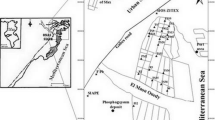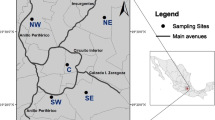Abstract
Background, aim and scope
Murano’s glass-makers have held a monopoly on quality glass-making for centuries known all over the world. Artistic glass manufacture entails exposure to complex mixtures of pollutants, including metals. A few studies have reported high levels of trace elements in marine waters, sediments and mussels around Murano and shown that emissions from Murano glass-making workshops significantly influence air quality in the Venice area. Nevertheless, to date, there is very little information on atmospheric concentrations and virtually none on atmospheric deposition fluxes of trace elements around the island. This study presents data on the distribution of trace elements in the air and atmospheric depositions around Murano, based on a 2-year sampling period.
Materials and methods
Airborne PM10 particulate matter was collected daily in the period December 2001–June 2003 (254 air samples), and atmospheric depositions were collected every 19 ± 6 days, in the period August 2001–July 2003 (38 samples) on the roof of the Experimental Glass Laboratory on the island of Murano. All samples were analysed by ICP-MS for As, Cd, Cr, Cu, Fe, Mn, Ni, Pb, Sb, Se and Zn contents.
Results
Atmospheric concentrations of As, Cd, Cr, Ni, Pb, Se and Zn were 1–2 orders of magnitude greater on the island of Murano than in the nearest urban areas (Venice and Mestre), with values higher than those reported for European industrial sites. The atmospheric deposition fluxes of all elements were also higher in Murano than those detected by other studies in Venice and Mestre and in the Porto Marghera industrial zone, with As, Cd, Sb and Se 1–2 orders of magnitude higher.
Discussion
In order to study the spatial variability of the atmospheric fall-out, data from other sampling stations belonging to Venice atmospheric deposition monitoring networks were used. A decreasing gradient from Murano to the closer leeward stations was observed for As, Cd and Se. Pb and Zn deposition fluxes in Venice were also comparable to those observed in the Porto Marghera industrial zone, thus, indicating a similar or even higher level of contamination. Principal component analysis confirmed significant contamination from the glassworks.
Conclusions
As shown by our study, atmospheric loadings of metals around Murano are significant. These observations confirm that emissions from Murano also significantly influence atmospheric deposition in the Venice area. Specifically, the mean daily Cd flux in the most affected area, which includes the whole of the historic city centre of Venice, is ~18 µg m–2 day–1, i.e. more than 65 times higher than the Dutch limit and more than three times higher than that of Germany.
Recommendations and perspectives
On the basis of our data, there is a clear-cut need for remedial action in the Lagoon of Venice. Monitoring is indispensable, so that the efficacy of remedial measures can be evaluated and appropriate information about risks for human health and well-being can be made available. The atmospheric compartment must also be considered by Italian and European law which, until now, has not yet established any standard for atmospheric deposition.




Similar content being viewed by others
References
Apostoli P, Giusti S, Bartoli D, Perico A, Bavazzano P, Alessio L (1998) Multiple exposure to arsenic, antimony, and other elements in art glass manufacturing. Am J Ind Med 34:65–72
Bettiol C, Collavini F, Guerzoni S, Molinaroli E, Rossini P, Zaggia L, Zonta R (2005) Relative contribution of atmospheric and riverine inputs of metals, nutrients and POPs into the lagoon of Venice. Hydrobiologia 550:151–165
Carrera F, Cerasuolo M, Tomasin A, Canestrelli P (1995) La nebbia a Venezia nel quarantennio 1951–1990. Analisi comparata degli andamenti di visibilità, pressione, temperatura e vento. Istituto Veneto di Scienze, Lettere ed Arti. Rapporti e Studi 12:235–271
Council Directive 1999/30/EC of 22 April 1999 relating to limit values for sulphur dioxide, nitrogen dioxide and oxides of nitrogen, particulate matter and lead in ambient air
Di Domenico A, Turrio Baldassarri L, Ziemacki D, De Felip E, Ferri F, Iacovella M et al (1997) Selected carcinogenic organic microcontaminants and heavy metals in the Venice Lagoon. Organohal Comp 34:54–60
Directive 2004/107/EC of the European Parliament and of the Council of 15 December 2004, relating to arsenic, cadmium, mercury, nickel and polycyclic aromatic hydrocarbons in ambient air
Commission European (1997) Air quality daughter directives—Position Paper on lead. European Commission, Brussels
Commission European (2000) Ambient air pollution by As, Cd and Ni compounds—Position Paper. European Commission, Brussels
Giusti L, Zhang H (2002) Heavy metals and arsenic in sediments, mussels and marine water from Murano (Venice, Italy). Environ Geochem Health 24:47–65
Gorniz V, Fairbridge RW, Ammerman AJ, McClennen CE (2000) The vulnerability of Venice. Science 290:2259–2260
Guerzoni S, Rampazzo G, Molinaroli E, Rossini P (2005) Atmospheric bulk deposition to the lagoon of Venice: part II, source apportionment analysis near industrial district of Porto Marghera, Italy. Environ Int 31:975–982
Harrison RM, Yin J (2000) Particulate matter in the atmosphere: which particle properties are important for its effects on health? Sci Tot Environ 249:85–101
Mantovan I, Rado N, Rampazzo G, Visin F (2003) Correlations among inorganic elements in particulate matter (PM10) in urban area of Venezia-Mestre. Ann Chim (Rome) 93:421–428
Rampazzo G, Masiol M, Visin F, Rampado E, Pavoni B (2008) Geochemical characterization of PM10 emitted by glass factories in Murano, Venice (Italy). Chemosphere 71:2068–2075
Rossini P, Guerzoni S, Molinaroli E, Rampazzo G, De Lazzari A, Zancanaro A (2005) Atmospheric bulk deposition to the lagoon of Venice: Part I, fluxes of metals, nutrients and organic contaminants. Environ Int 31:959–974
Scalet BM (1998) Chemical nature of dust emissions from soda-lime glass production and their environmental impact. Int Glass J 97:55–58
Scalet BM, Slade S, Kasper A, Van Marcke Lummen G, Gitzhofer K, Van Limpt H (2006) Selenium emission from glass melting furnaces: formation, sampling and analysis. Glass Technol 47A:29–38
Scazzola R, Matteucci G, Chiamenti E, Guerzoni S, Rossini P, Molinaroli E (2004) Evaluation of trace metal fluxes to soils in the hinterland of Porto Marghera, industrial area: comparisons with direct measurements in the lagoon of Venice. Water Air Soil Poll 153:195–203
Querol X, Alastuey A, Moreno T, Viana MM, Castillo S, Peya J, Rodríguez S, Artiñano B, Salvador P, Sánchez M, Garcia Dos Santos S, Herce Garraleta MD, Fernandez-Patier R, Moreno-Grau S, Negral L, Minguillón MC, Monforte E, Sanz MJ, Palomo-Marín R, Pinilla-Gil E, Cuevas E, de la Rosa J, Sánchez de la Campa A (2008) Spatial and temporal variations in airborne particulate matter (PM10 and PM2.5) across Spain 1999–2005. Atmos Environ 42:3964–3979
Wenning R, Dodge D, Peck B, Shearer K, Luksemburg W, Della Sala S et al (2000) Screening-level ecological risk assessment of polychlorinated dibenzo-p-dioxins and dibenzofurans in sediments and aquatic biota from the Venice Lagoon, Italy. Chemosphere 40:1179–1187
Acknowledgements
This work was carried out with the aid and collaboration of Dr. Bianca Maria Scalet (Stazione Sperimentale del Vetro, Murano). The authors thank the Venice District Administration, Venice Municipality and Venice Water Management Authority for atmospheric deposition data. George Metcalf and Gabriel Walton revised the English text. This is contribution no. 140 of the Istituto di Ricerca Gruppo CSA.
Author information
Authors and Affiliations
Corresponding author
Additional information
Responsible editor: Constantini Samara
Rights and permissions
About this article
Cite this article
Rossini, P., Matteucci, G. & Guerzoni, S. Atmospheric fall-out of metals around the Murano glass-making district (Venice, Italy). Environ Sci Pollut Res 17, 40–48 (2010). https://doi.org/10.1007/s11356-009-0122-8
Received:
Accepted:
Published:
Issue Date:
DOI: https://doi.org/10.1007/s11356-009-0122-8




